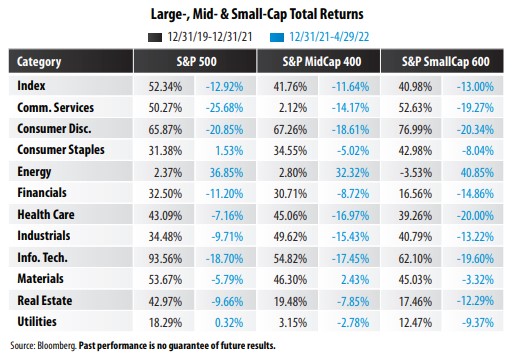
View from the Observation Deck
1. All three S&P stock indices in the table above recently dipped into correction territory. The returns in blue ink reflect year-to-date total returns.
2. A correction is usually defined as a 10.00% to 19.99% decline in the price of a security or index from its most recent peak. A bear market is defined as a 20.00% or greater decline in the price of a security or index.
3. As of the close on 4/29/22, the S&P 500 Index stood 13.86% below its all-time closing high, according to Bloomberg. The S&P MidCap 400 and S&P SmallCap 600 Indices stood 14.10% and 17.14% below their respective all-time highs. All three major stock indices are in correction mode.
4. The three major indices featured in the table comprise the S&P Composite 1500 Index, which represents approximately 90% of total U.S. equity market capitalization (cap), according to S&P Dow Jones Indices.
5. Large-cap stocks performed significantly better than their mid- and small-cap counterparts from 2020-2021 (black columns). YTD through 4/29/22, while large-caps have topped the performance of small-caps, they have lagged mid-caps (see table above). From 12/31/19 through 4/29/22 (period covered in the table that captures the COVID-19 pandemic), the S&P 500, S&P MidCap 400 and S&P SmallCap 600 Indices posted cumulative total returns of 32.70%, 25.30%
and 22.80%, respectively, according to Bloomberg.
6. Sector performance can vary widely by market cap (see table). A couple of the more extreme cases (2020-2021) include Information Technology, Real Estate and Utilities. So far in 2022, it is Consumer Staples, Health Care and Materials.
7. As of 12:00PM CST on 5/2/22, the percentage of stocks in the S&P 500, S&P MidCap 400 and S&P SmallCap 600 Indices trading above their 50-day moving averages were 21%, 19% and 19%, respectively.
8. The percentage of stocks in the S&P 500, S&P MidCap 400 and S&P SmallCap 600 Indices trading above their 200-day moving averages were 32%, 26% and 24%, respectively.
9. Moving averages tend to smooth out day-to-day price fluctuations and can be a useful tool for traders and investors to identify both positive trends and reversals, in our opinion.



